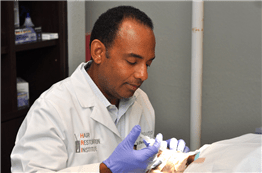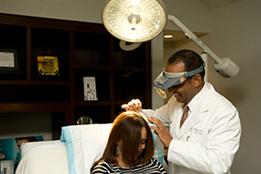International Leader In Functional Medicine
Bellissimo Medical in Weston and Miami, Fl.TOP 10 CAUSES OF HAIR LOSS
Genetics can play a big part; hormones often take the blame; medical conditions are certainly the agents, and even the innocent blow drying can be the villain. We’re talking of course about hair loss!
The normal cycle of hair growth lasts for 2 to 3 years. During this phase each hair grows approximately 1 centimeter per month. About 90 percent of the hair on your scalp is growing at the same time, whereas the remaining 10 percent of your hair is in a resting phase. After a 3 to 4 month period, the resting hair falls out and new hair starts to grow in its place. It is normal to shed some hair each day as part of this cycle, approximately 50 to 100 hairs.
1. Telogen Effluvium
This condition, which typically occurs after pregnancy, major surgery, extreme stress or weight loss, causes massive amounts of hair loss daily. Usually loss occurs during the washing, styling and brushing of the hair. Telogen Effluvium can also be a side effect of certain medications, such as antidepressants, beta-blockers, and anti-inflammatory drugs. What you can do: In some cases you may have to take your time and wait until the hair loss gradually lessens. If medication is the culprit, talk to your doctor about lowering your dosage or switching drugs. When condition is stress related, do your best to reduce anxiety.
2. Hypothyroidism
When your body does not produceenough thyroid hormones, this condition occurs. The thyroid hormone is responsible for everything, from your metabolism to your nails. To diagnose this condition, take a blood test to measure the thyroid-stimulating hormone. Don’t forget to ask your doctor to test for Free T3, which is the active hormone. What you can do: After getting a diagnosis, follow up by contacting a certified Functional Medicine Doctor in order to be treated with a natural medicine rather than the typical synthetic hormone, which can continue the cycle of hair loss.
3. Lupus
This chronic autoimmune disease, which affects up to 1.5 million people, causes your body’s own immune system to attack the remaining healthy tissues. Lupus, which primarily affects women, infects nearly every tissue or organ in one’s body causing painful joints, rashes, anemia, fatigue, ulcers and hair loss. Specialized tests are recommended for this disease and are usually performed by a rheumatologist. What you can do: Treating the disease with medication typically produces the best results in reducing hair loss along with the other symptoms mentioned.
4. Polycystic Ovarian Syndrome
Up to 5 million women in the US suffer from PCOS; the condition ranges from young women starting as early as 11 to women in their 50’s. PCOS is caused when a hormonal imbalance occurs because the ovaries produce too many male hormones, also affecting estrogen and progesterone. Symptoms include facial hair growth, irregular periods, acne, and cysts on the ovaries. While you may experience hair loss, you may notice unwanted hair elsewhere on the body. Blood test to include estrogen, testosterone, progesterone, DHEA, and sometimes an ovarian sonogram will help diagnose this disorder. What you can do: Traditional medicine will treat with a birth control pill, only temporarily fixing the hormonal issue, whereas a certified Functional Medicine doctor will do more specialized testing and will correct the hormonal balance that is required for a healthy body.
5.Chemotherapy/Radiation
Drugs designed to kill cancer cells also poison the hair follicles and often result in total hair loss. Hair found on your scalp is most affected by the drug. This may cause the scalp to become tender, and the hair that continues to grow becomes dry and brittle. Hair loss typically begins after a few weeks; total hair loss normally occurs after 3-4 months. After 3-4 months chemo treatment finished, hair begins to grow again. As hair grows back, it may be thinner and with a different color, due to the absence or change of pigment. In most cases hair eventually returns to its original texture and color. What you can do: Treatment can be accelerated by making up for the lost minerals that were taken away during treatment such as with IV Nutrition provided by a certified Functional Medicine Doctor.
6. Hereditary Hair Loss
This is the most common cause of hair loss, and is known as “Androgenetic Alopecia”. When this condition occurs, it is because it was passed down from either one of your parents, or both! What you can do: Lessen the decreasing hair by applying Rogaine, for both men and women, all over the scalp. Men can also use Propecia. If this does not meet your needs, then you can treat your hair loss, by investing in hair implants.
7. Skin conditions of the scalp
An unhealthy scalp can cause inflammation that makes it difficult for hair to grow. Skin conditions that lead to hair loss include Seborrheic dermatitis, psoriasis, and fungal infections such as ringworm. Such conditions can cause the scalp to shed its skin; you may experience hormonal changes, or excessive oil in the skin. A physical exam of the scalp will help determine your condition. What you can do: Use medicated shampoo, traditional medication or light therapy depending on the magnitude of the disease involved.
8. Iron Deficiency/Anemia
Women who have heavy periods or do not eat enough iron-rich foods may be prone to iron deficiency, in which the blood does not have enough red blood cells. Red blood cells transport oxygen to the cells located throughout your body, giving you the energy you need. Therefore when your body lacks red blood cells the symptoms include fatigue, weakness, pale skin, headaches, difficulty concentrating, cold hands and feet, and hair loss. Simple, inexpensive blood tests can be taken to diagnose this common condition. Replacement of iron is necessary if tests indicate deficiency. What you can do: Eat iron-rich foods such as beef, pork, fish, leafy greens, fortified cereals, and beans.
9. Alopecia Areata
4.7 million people in the US alone are affected by this autoimmune disorder in which the immune system attacks hair follicles. The cause of this disorder is unknown, but some speculate it may be triggered by stress or illness. The symptoms cause round, smooth patches of baldness on the scalp, eyebrows, or legs. Observing the pattern of hair loss can usually determine if you have Alopecia Areata. Blood tests for iron, ANAs, and hormone imbalance can be taken for other possible causes of hair loss. What you can do: It can be treated with steroids injections. Rogaine and Platelet Rich Plasma may also help.
10. Excessive styling
Too much shampooing, styling, and dyeing can harm your hair. Heat, chemicals from keratin, straightening treatments, and hair dye cause the hair to break and fall out. What you can do: Test this by using the pull test: take a small handful of about 50 strands, pull gently, and check to see whether the hair that comes out has bulbs on the ends. Remove the source of trauma and let the area affected recover.
Simplify treatment financing with flexible payment plans
Our goal is to help each patient receive the results they seek, and offer a refreshingly pleasant experience in the process.
These are economical alternatives to most personal loans and credit cards.
Visit our merchant partners and find out which one works for you.
(click on the image of your choice for more information)










